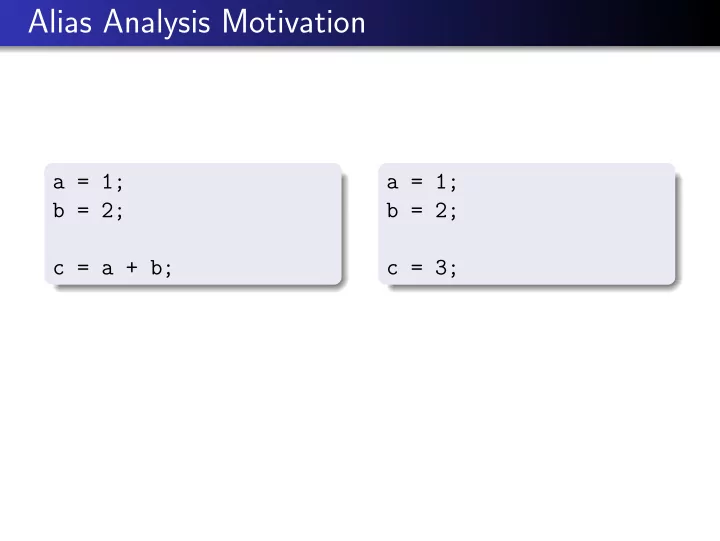

Alias Analysis Motivation a = 1; a = 1; b = 2; b = 2; c = a + b; c = 3;
Alias Analysis Motivation a = 1; a = 1; b = 2; b = 2; *x = 4; *x = 4; c = a + b; c = ???;
Alias Analysis Motivation a = 1; a = 1; b = 2; b = 2; *x = 4; *x = 4; c = a + b; c = ???; If x must equal &a , c = 6 . If x must equal &b , c = 5 . If not ( x may equal &a or x may equal &b ), c = 3 .
Sources of Aliases 1. Call by reference int f(var x, var y) { x = 1; y = 2; return x + y; }
Sources of Aliases 1. Call by reference int f(var x, var y) { x = 1; y = 2; return x + y; } int z = 1; z = f(z, z);
Sources of Aliases 2. Address-of operator int a; int* x = &a; 3. Dynamic memory allocation int* x = malloc(sizeof(int)); 4. Array expressions a[x] = 1; a[y] = 2; c = a[x]; // is c = 1 or 2?
Address Taken a = 1; b = 2; *x = 4; c = a + b; IF &a , &b never occur in the program, THEN x can never equal &a or &b . (except for evil pointer arithmetic) Local variables: in Java, address cannot be taken in C, quite rare to take their address
Type-Based Analysis double* x; int a = 1; int b = 2; *x = 4; c = a + b; IF the language enforces declared types, THEN x can never equal &a or &b .
Alias Pairs vs. Points-To Sets Alias pairs ( α, β ) if the expressions α and β must/may point to the same location Points-to sets o ∈ pt ( p ) if p must/may point to o
Flow-sensitive vs. Flow-insensitive Flow-sensitive Compute separate analysis information at each program point. Consider order in which statements execute. Allow strong updates. Flow-insensitive Compute single result for whole program (which holds at every program point). Ignore statement execution order. Only weak updates allowed.
Subset-based vs. Equality-based Assignment statement: x = y Subset-based aka Propagation-based aka Andersen pt ( y ) ⊆ pt ( x ) x points to everything that y points to. O ( n 3 ) in theory. Equality-based aka Unification-based aka Steensgaard pt ( y ) = pt ( x ) x and y point to the same set of objects. O ( n α ( n )) but less precise.
Equality-based points-to analysis Let S = { s 1 , s 2 , s 3 , ... } be the set of all possible targets of pointers. We partition it into disjoint subsets, and model each pointer to point to one of the disjoint subsets. Example p = &x; q = &y; p = q; r = &z; Example a = &b; b = &c; a = &d; d = &e;
Field Sensitivity Field Field Field Sensitive Insensitive Based Abstraction o.f o.* *.f Efficiency slowest medium fastest single iteration Precision most precise very imprecise medium for OO-style code Soundness only if field types enforced Language Java, C C Java
Recommend
More recommend